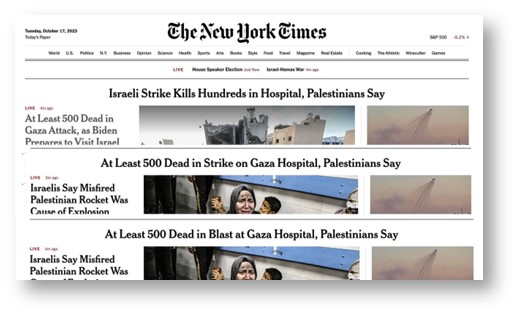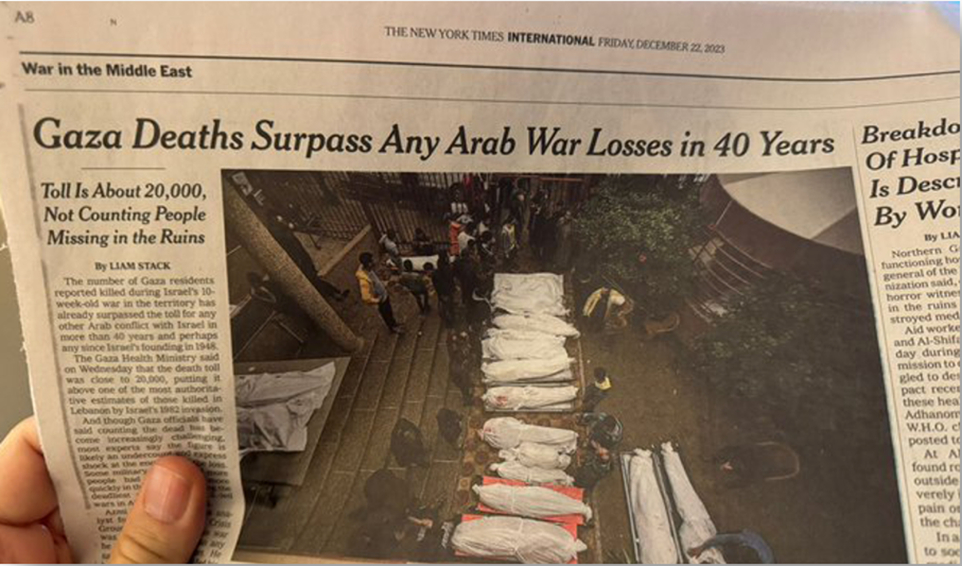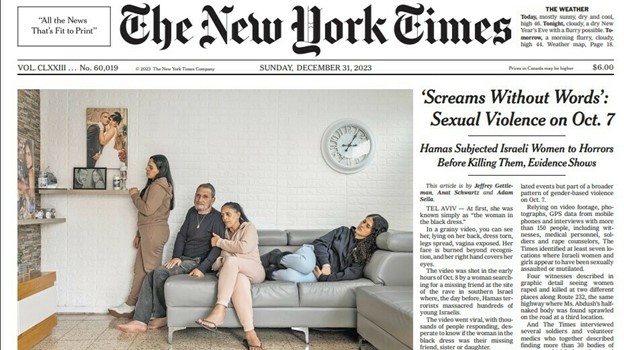The way media organizations frame the wars they cover can significantly influence leaders, legislators, international organizations and public opinion. Media coverage of wars is crucial to the understanding of violent events and can determine the results of warfare almost as much as victories on the battlefield. It is therefore critical to be accurate.
Between October 7, 2023, and June 7, 2024, The New York Times (hereinafter the “Times”) admitted 72 errors in its coverage of the current war between Israel and Hamas. More Times errors have been exposed through other media outlets. This article analyzes the boldest of these errors.
The Al-Ahli Hospital explosion
On October 17, 2023, the lead headline on the Times website said: “Israeli Strike Kills Hundreds in Hospital, Palestinians Say.” This massively distributed report caused major riots around the world and forced King Abdullah of Jordan to cancel a critical summit with US president Joe Biden, Egyptian president Abdel Fattah al Sisi, and Palestinian leader Mahmoud Abbas. But the headline was entirely false. It was a failed Palestinian rocket, not an Israeli airstrike. It was fired by Palestinian Islamic Jihad (PIJ), not the Israeli Air Force. It fell on the hospital parking lot, not the hospital itself. It killed 50-100 Palestinians, not 500. And the source was the Hamas-controlled Ministry of Health, not “Palestinians.”

Israel denied the report and produced a recording of a conversation between PIJ fighters who admitted that the failed launching had caused the explosion. But in its subsequent updates, the Times placed the denial in a smaller headline underneath the original one, implying to readers that the former was more reliable. Three days later, the Times published a vague correction in a ridiculous attempt to evade admitting that it had made a substantial error that caused a major setback to US policy.
The Times was heavily criticized for “mindless amplification of terrorist propaganda” and for failing to disclose that the source of information on the October 7 atrocities was “the same Hamas whose officials continue to claim that they didn’t kill any civilians despite livestreaming the slaughter themselves.” It was also criticized for giving Hamas “more credence than the claims of on-the-record Israeli military personnel offering tangible evidence.” Only after a rebuke from the White House did the paper finally admit its colossal error. The editor’s note said that “early versions of the coverage relied too heavily on claims by Hamas” and “left readers with an incorrect impression.” Times executive editor Joe Kahn promised to “reflect” and employ an “extra degree of scrutiny”.
Misreporting civilian casualties in Gaza
Gaza casualty figures have also been a major issue during the war. They influenced President Biden, Vice President Kamala Harris, then-British PM Rishi Sunak, PM of Spain Pedro Sanchez, and the UN and its international courts in the Hague. Following the Al Ahli fiasco, one would have expected more scrutiny of any information circulated by Hamas and its controlled ministries. At the Times, this wasn’t the case.
On November 25, 2023, the Times published an article claiming that the rate of killing of civilians in Gaza by Israel is almost unprecedented in this century, even when compared to Russia and Ukraine. This blatantly false argument was quickly refuted by blogger David Lisovtsev. The Times admitted the error by erasing the paragraph that described the false comparison to Ukraine from its website, but without disclosing the correction. Syndicated versions of this article still appear with the original error.

On December 22, 2023, another absurd headline in the Times international edition declared that “Gaza Deaths Surpass Any Arab Loss in Wars in Past 40 Years.” Other wars in Arab countries, such as those in Syria, Lebanon, Iraq, and Yemen, have each caused the deaths of hundreds of thousands of people. After being mocked online, the Times issued a correction.
Several studies expressed strong doubts about the Gaza casualty figures. One defined them as “statistically impossible”. Another emphasized that they were based on media reports and not hospital records. Others noted that when examined statistically, the numbers reveal themselves to have been “poorly fabricated” because they “increase with almost metronomical linearity.”
The Times failed to mention any of these studies. John Spencer, one of the world’s leading experts in urban warfare, repeatedly showed that “Israel has taken more measures to avoid needless civilian harm than virtually any other nation.” He showed that while the civilian-to-combatant’ casualty ratio is 1:9 in modern war, Israel holds an unprecedented ratio of “roughly 1 combatant to 1.5 civilians”. The Times systemically omitted Spencer’s analysis of casualties in Gaza, though it has quoted him on other warfare issues as a credible source.
When the Gaza Health Ministry finally admitted to incomplete data about one-third of its reported casualties, the Times omitted the initial report. It addressed the issue a week later after the UN released a similar admission, but still did not raise any doubts about the credibility of the data. The paper has repeated Hamas’s manipulated casualty numbers almost daily throughout the war, usually without noting that Hamas does not differentiate between combatants and civilians in an effort to make the civilian toll seem much higher. Estimates of killed Hamas combatants were available regularly through Israeli officials and were close to half of Hamas’s reported casualties, but the Israeli estimates were almost never cited.
Employing questionable journalists
On November 8, 2023, Honest Reporting published a report about photojournalists who breached the Israel-Gaza border on October 7 along with Hamas terrorists and then sold photos of the atrocities to leading media outlets. Since 2007, Gaza has been ruled by Hamas, a ruthless Islamic theocracy that has never respected freedom of the press. The question was whether these individuals were legitimate photojournalists or infiltrators working for Hamas.
AP and CNN cut ties with their photojournalists in question, but the Times firmly denied the allegations about its freelance photographer, Yousef Masoud. In a dedicated article, the Times claimed its editors “determined that the first photo he transmitted to the AP was taken more than 90 minutes after the attack began” and that “he was woken at home in Khan Younis by the sound of rocket fire, shortly after 5:30 A.M. on Saturday morning, later making his way to the border.” This statement was false. Hamas began launching rockets at 6:30 A.M., not 5:30 A.M. On November 12, 2023, after being publicly challenged about this, the Times issued a correction about “misstating when Yousef Masoud woke to the sound of rocket fire. It was shortly after 6:30 A.M., not 5:30 A.M.”
But the AP image database showed that Masoud’s photo was created at 6:41 A.M. – that is, 11 minutes and not 90 minutes after the attack had started. The evidence did not match the Times’s claims either before or after the correction, and phrasing the correction as if the error had been a mere typo was also misleading. The Times went on to issue two other statements supporting the photojournalist, stressing its “defense of freelance photojournalists working in conflict areas” which is “the essential role of a free press in wartime.” None of the statements addressed the fact that Masoud, like all photojournalists in Gaza, has never been able to act as a member of the free press, which is forbidden by Hamas.
When approached about this incident by the authors of this article, a spokesperson for the Times said the case “is flatly false and has been widely debunked.” It has been repeatedly denied by the paper itself, but has never been debunked. In fact, AP, which was the first to publish Masoud’s photograph, is being sued in federal court by survivors of October 7 for hiring freelance photographers who embedded with terrorists as they invaded Israel. The IDF has also identified several men killed during the war who were supposedly journalists but were serving in Hamas’s army.
Testimonials from inside the newsroom
James Bennet, former editorial page editor of the Times, offered broad context for the Times’ errors in a long essay in the Economist, titled “How the New York Times Lost its Way”. He wrote that the Times’s problem “has metastasized from liberal bias to illiberal bias… (infected by) pressures of intolerance and tribalism.” Bennet thought the ethical deterioration was a reaction to the fierce competition from “digital natives” like Vox and HuffPost. He added,
The rise of opinion journalism over the past 15 years changed the newsroom’s coverage and its culture. Times readers are being served a very restricted range of views, some of them presented as straight news. And yet the Times insists to the public that nothing has changed. By saying that, the paper leads its readers further into the trap of thinking that what they are reading is independent and impartial – and this misleads them.
Judith Miller, formerly a Times Pulitzer Prize-winning investigative reporter, seconded Bennet’s claims. She said they were joining “a growing body of criticism by former Times insiders”, explaining that “reporters and even interns who once lived in fear of their editors now made their editors fear.” She testified that the news division “quietly erased” false reports from its digital version “after historians and readers expressed outrage and pointed out errors.” She concluded that the paper was once committed to covering news “without fear or favor” but that while it still does “some extraordinary reporting, it is doubtful that its reputation for slanted, ideologically driven journalism can be reversed.”

These testimonies shed light on another challenge the Times faces. On December 28, 2023, the Times published a comprehensive investigation of Hamas’s weaponized rape and savage sexual abuses of Israeli women on October 7. Contrary to the errors analyzed above, which were belatedly addressed by the paper itself, the sex crimes investigation was led by Jeffrey Gettleman, an experienced Pulitzer Prize-winning journalist; was conducted for over two months; relied on over 150 testimonies; and received exceptional praise from the editor-in-chief, Joe Kahn, who described it as a “signature piece.”
The publication of this piece, which should have been a moment of correction that restored at least some of the Times’s credibility, was a fiasco that had the opposite result.
Apparently, some journalists at the Times felt that the investigation into Hamas’s sexual atrocities against Israeli women was damaging to the cause they favored, and opposed publishing the piece. After failing to convince the editors to shelve it, they attacked the Times’s credibility by leaking internal information to a radical left pro-Hamas media outlet. The leaked details reverberated across pro-Hamas outlets that falsely claimed that the investigation had been “debunked,” “unraveled,” and “discredited.”
After months of an internal feud that was constantly leaked, the Times formally stood by the investigative piece but effectively conceded to its internal “newsroom intifada”. First, it publicly fired the Israeli reporter who collected the testimonies for “liking” a pro-Israeli post on social media. Second, it published a new article that partially contradicted one of the testimonies.
The Times tried to conduct an internal investigation to find the leakers who felt that “the suffering of Gazans isn’t getting the same attention” – but the investigation ran up against the union, which alleged that “the company was targeting a group of staffers of Arab and Middle Eastern descent”. The investigation ended with no conclusion.
The allegations against the Times’s sexual violence investigation were entirely bogus. The Undersecretary-General of the UN and the Special Representative on Sexual Violence in Conflict had also published a report about Hamas’s sexual crimes against Israeli women that reached the same conclusion: that “conflict-related sexual violence — including rape and gang-rape — occurred across multiple locations of Israel and the Gaza periphery during the attacks on 7 October 2023.” Sheryl Sandberg, former chief operating officer of Meta Platforms, had also produced a documentary film that presented many testimonies to barbaric rape attacks on October 7, including taped admissions of Hamas fighters. The Times never mentioned the film in its news reports.
Times reporters not affiliated with the “newsroom intifada” testified that some “staffers do not want to investigate the sexual violence that occurred on October 7. They see it as a vulnerability to their own side in the information war about Gaza.” It appears, therefore, that the Times journalists who questioned the sexual violence investigation were not obligated to concern themselves with either accuracy or fundamental standards of journalistic ethics. These journalists used every kind of leverage they could to force the senior professional staff to align with their radical views. They were even helped by a group of journalism professors who asked to “review the investigation” and were subsequently severely criticized as more interested “in joining an ongoing propaganda war than in righting a journalistic wrong”.
At the Times, not only are errors regularly concealed and there are no consequences for journalists who abuse their position to serve their own ends, but instances of genuinely professional journalism about the war in Gaza that manage to appear in its pages are attacked and publicly humiliated. The Times even retreated from its original intention to submit the sex crimes investigation for the Pulitzer Prize.
Conclusion
The many serious errors that have characterized the Times’s coverage of the war in Gaza were not occasional failures but represent an endemic malaise. Disturbingly, Times corrections are used as a Band-Aid to cover up much bigger reporting failures, not as a tool to improve. The Editor’s Note after the Al Ahli Hospital fiasco attributed the failure to “relying too heavily on reports by Hamas,” but that practice did not change. The paper’s casualty reports throughout the war have relied almost exclusively on the Hamas–controlled Gaza Ministry of Health– a fact that is hardly ever mentioned.
Repeated omissions of IDF statements about journalists who were active Hamas operatives show that the Times prefers to believe Al Jazeera, a questionable news organization serving an autocratic leader, over the IDF, a formal institution of a democratic country.
The Times is not alone in a fast-changing digital world in which journalistic ethics are less respected than they once were. But the Times is widely syndicated and imitated. It pretends nothing has changed, but its newsroom has in fact radically changed and no longer upholds the standards it once did. This misleads many readers who still believe they are consuming accurate and impartial information.
{Reposted from BESA}
















